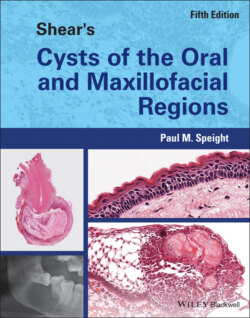Читать книгу Shear's Cysts of the Oral and Maxillofacial Regions - Paul M. Speight - Страница 40
Clinical Presentation Radicular Cyst
ОглавлениеAn essential criterion for the diagnosis of a radicular cyst is that it is always associated with a tooth with a non‐vital pulp, usually as a result of dental caries.
Many radicular cysts are small and symptomless and are discovered by chance during radiological examination of caries or non‐vital teeth. Overall, however, radicular cysts are probably the most common cause of swelling of the jaws and a slowly enlarging swelling is a common presenting complaint. At first the enlargement is bony hard, but as the cyst increases in size, the cortical plate is resorbed and only a thin layer of subperiosteal new bone covers the lesion. The swelling then exhibits ‘springiness’ or ‘egg‐shell crackling’. Only when the cyst has completely eroded the bone, often due to secondary infection, will the lesion be fluctuant. In the maxilla there may be buccal or palatal enlargement, whereas in the mandible it is usually labial or buccal and only rarely lingual.
Radicular cysts may occasionally be associated with pain, but this is usually pulpal in origin, or is due to secondary infection, when there may be a sinus leading from the cyst cavity to the oral mucosa. However, even infected lesions may be symptomless. In a histological examination of 25 radicular cysts, Vier and Figueiredo (2002 ) showed that 21 contained abscess cavities that disrupted the epithelial lining. This suggests that although secondary infection may be quite common, it is not often a cause of pain. Conversely, some patients complain of pain, although no evidence of infection is found clinically and no evidence of acute inflammation is seen histologically after the cyst has been removed.
Quite often, a patient may have multiple radicular cysts. Usually this is clearly associated with dental caries in multiple teeth, but the fact remains that radicular cysts are relatively rare in relation to the vast numbers of grossly carious teeth with dead pulps. This has led a number of authors to believe that there are cyst‐prone individuals who show a particular susceptibility to developing radicular cysts (Oehlers 1970 ). It is possible that in most people periapical infections are suppressed and cyst formation is inhibited, but that cyst‐prone subjects have a defective immunological surveillance and suppression mechanism. Multiple radicular cysts may also be seen in patients with hereditary dental defects (e.g. multiple dens‐in‐dente or dentinogenesis imperfecta), but in these cases this is because of morphological defects resulting in increased caries or early exposure and death of the pulp.
Radicular cysts arising from deciduous teeth appear to be very rare. Shear found that of 1300 radicular cysts recorded in his department at the University of the Witwatersrand over a 25‐year period, only 7 were associated with deciduous teeth (0.5%). In an extensive review of the literature from 1898 to 1985, only 28 cases were found (Lustmann and Shear 1985 ). Subsequent reviews have recorded 112 cases up to 2004 (Nagata et al. 2008 ) and a total of 122 up to 2010 (Shetty et al. 2010 ).
The frequency is probably higher than these figures would suggest, because many lesions may not be diagnosed before the deciduous teeth are extracted or exfoliate, and lesions may not be submitted for histological examination. Nevertheless, the frequency is substantially lower than of radicular cysts associated with permanent teeth and one may speculate on the reasons for this. It may be due to the fact that pulpal and periapical infections in deciduous teeth tend to drain more readily than those of permanent teeth. Caries is almost always the aetiological factor, although in over half of all cases reported there has been previous pulp therapy, suggesting that medicaments used in pulpotomy may be an additional aggravating factor by perpetuating chronic inflammation (Grundy et al. 1984 ; Shetty et al. 2010 )
In the study of Lustmann and Shear (1985 ), 23 personally observed cases were reported. The patients' ages ranged from 4 to 12 years, with one exceptional case aged 19 years. The M : F ratio was 1.6 : 1. The mandible was affected more frequently than the maxilla and the deciduous molars were the teeth most often involved. In 9 cases buccal expansion was noticed and in 8 cases the permanent tooth buds were displaced. Mass et al. (1995 ) gave a detailed account of 36 cases, of which 22 (61%) were associated with mandibular molars. They also noted that the lesions are not associated with the apices of the teeth, but usually present as a periradicular radiolucency overlying the crowns of the unerupted permanent premolars. This makes diagnosis uncertain, since it may be difficult to differentiate a deciduous radicular cyst from a hyperplastic follicle or even a dentigerous cyst of the permanent successor, which in this context may be inflammatory in origin (the inflammatory dentigerous cyst is discussed in Chapter 5).
